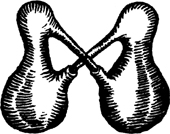
If the logos—locked in dogma by authority of a book—is an image of centrality, mythos might be seen not as peripheral (i.e., subordinate or secondary to the center) but as centrifugal. Myth is the centrifugal suction pulling centers apart into other circles, new centers, rings, circles within circles expanding and contracting in a “steady bargain with the way things are.” What Derrida calls “arche-writing” is, ostensibly, composting poetry : nonlinear, denoting the transcendental signified of the Book, deferring all questions of origin and originality, yet referring them to writing as the disseminating medium that at once constitutes the book and leaks or even gushes from it. It is a problem of ostensible unity, addressed by Charles Stein in terms of monism.
Plato [and the Neo-Platonists after him and the Christians, Jews, and Moslems along with and after them, and much of the scientism after them] mistook the Parmenidean Vision of Undivided Being for a Doctrine of the One. This productive error afforded hierarchy in everything, and the finally gruesome spectacle of degrees of Being : you were with or in or possessed of Being just so much as you participated in a transcendent Unity. Thus has our UNIverse grown littered with Qliphotic existences deficient in being : shells, shards, leftovers, junk, weeds, outcasts, inappropriate subject matters, inadmissible behaviors, personae non gratae, inadmissible poems.
The spiritual praxis of the One aimed to advance beyond Being to a Good purified of contingency; the poetic work became a practice of exclusion that celebrated the hypertrophy of Unity : valorized ideal forms and universal, ideal voices. (“For Gerrit Lansing,” 41; brackets are in Stein)
Stein celebrates Lansing’s “genial occultism” as “an address from the contingency of intimate care that touches us not where we are Everyman—but where we are ourselves.” He takes such work to be instructively Parmenidean in affirming that “Being exceeds the One” and that “Unity is a function of experience, not what funds it”; so, for Lansing, “concerns are not authorized by anything but the tropisms of a vitalized attention, and the work of setting to rights the exclusions of western history is quietly and quite subversively accomplished” (41).
A problem remains : what do we do with the logos embedded in our words for disciplined research : archaeology, sociology, geology, psychology? The root, the social, the earth and psyche are subject to a logos, a generalization or common denominator imposed on them. But what is it? The word mythology is a conspicuous misnomer (or names a presumptuous science), but it affords a clue to one way around the dilemma. For the word mythology reminds us that myth, too, has its logos. As Heraclitus insisted, logos is common : speech joins us each by each. The points of contact become mutually interpenetrating inversions, one model of which is the alchemical figure of the double pelican:
Giambattista Vico’s description of this state is especially pungent. Drawing on his foundational axiom, “Because of the indefinite nature of the human mind, wherever it is lost in ignorance man makes himself the measure of all things” (New Science, para. 120), Vico argues that
as rational metaphysics teaches that man becomes all things by understanding them (homo intelligendo fit omnia), this imaginative metaphysics shows that man becomes all things by not understanding them (homo non intelligendo fit omnia); and perhaps the latter proposition is truer than the former, for when man understands he extends his mind and takes in the things, but when he does not understand he makes the things out of himself and becomes them by transforming himself into them (para. 405).
From Vico’s imaginative metaphysics it is not much of a leap to Heidegger, whose etymological reveries exemplify Vico’s insight. Heidegger’s essay on the logos seeks to restore a common dimension to the word : the logos is “the Laying that gathers”—a phrase that is itself a laying out of bait, an invitation to play, like laying down a line in jazz, fizzing up melodic alignments from the syncopated nudge. Heidegger’s language is not logical but tropological; his meditation here is guided by the overlapping stimulation of the German verbs lesen (to read, to gather) and legen (to lay, which he traces to the Greek legein from which logos comes).* The world passes through the mouth and this transit is the logos. The vitality of the term has practically vanished, because the logos of each scholarly discipline is held to be the special terminology setting it apart from the common. Confined in use to a suffix of specialization, the logos—which should be simply the word as available to all—is lost to thought, and only poets take thought in common words, finding that words commonly disclose the uncommon.
Conveniently, a poet coined the word psychosm, conjoining psyche and cosmos.* A psychosm would be a plexus of energy by which the universe is pivoted in mind, and psyche integrates a material world extending to cosmos—
that,
through us, the
hazel
might ripen, and the stars
into their
fall quadrants
drift.